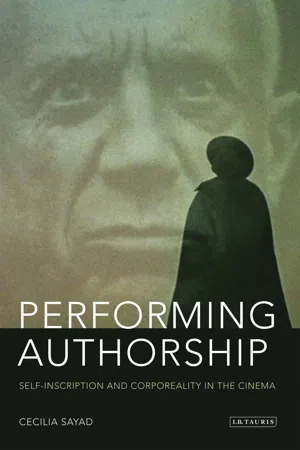1.1, 1.2 Two or Three Things I Know about Her: Characters look at the camera as they talk to an off-screen interviewer we know to be Godard
1.3, 1.4, 1.5 Paper Landscape: Guy Sherwin (live) paints a framed polythene surface on which emerges an image of the artist shot in 1975. Photo credits: John Suldholm (Photos 3 and 4) and Lynn Loo (from video documentation) (Photo 5)
2.1 JLG/JLG: For the most part we see Godard looking
2.2, 2.3 JLG/JLG: Frames break the space down into several planes, distancing viewers from both the author and the world
2.4 The Beaches of Agnès: The superimposition of shots of director (Varda in Beaches) walking backwards and actor (Corinne Marchand in Cléo) walking forwards creates a vertiginous effect
2.5, 2.6 The Beaches of Agnès: Embedded frames, zoom outs and jump cuts moving away from Varda remove us from the author’s image and produce a dizzying effect
2.7 The Beaches of Agnès: Mirrors on the beach intersperse the landscape with fragments of the whole, sometimes in distorting angles
2.8 The Beaches of Agnès: A framed mirror mounted on an easel evokes a painting
2.9 Perestroika: The reflected image of Sarah Turner briefly flashes before our eyes
2.10, 2.11 F for Fake: Orson Welles portrays the author as trickster and magician
2.12, 2.13 F for Fake: Elmyr forges Welles’s signature onto a portrait of Michaelangelo
3.1 The Human Pyramid: Jean Rouch explains the rules of the game to a group of teenagers
3.2 Chronicle of a Summer: Morin and Rouch in the feedback session after the screening of the shot material to the documentary subjects
3.3, 3.4 Chronicle of a Summer: Rouch and Morin discuss the received feedback as they stroll through the Musée de l’Homme
3.5 Playing: The stage of an empty theatre constitutes the space of the interview, with the subjects sitting with their backs to the stalls
3.6, 3.7 Whereas in Edifício Master Coutinho and his crew go to the subjects, in Playing it is the subjects that go to the filmmakers
3.8, 3.9 Playing: Actress Andréa Beltrão wipes her tears as she reproduces the testimony given by Gisele, who had not cried
4.1, 4.2, 4.3 Allen’s eyeglasses stand out and do not allow for the actor–director’s full submersion into the characters he interprets in Sleeper, Love and Death and Everything You Always Wanted to Know about Sex… But Were Afraid to Ask
4.4 First Name: Carmen: Godard’s character refuses to engage with the conversation (and the narrative), remaining at the margins
4.5 Soigne ta droite: The Prince/the Idiot is banned from a world that cannot accommodate the innocent and pure
4.6, 4.7 Meetin’ WA: Godard’s image dissolves into a portrait of Woody Allen
4.8 Annie Hall: The real irrupts within the fiction when Allen ‘produces’ Marshal McLuhan from behind a board to support his character’s arguments against an arrogant professor



